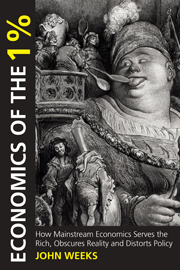Book contents
- Frontmatter
- Dedication
- Contents
- Preface: Doctor Bob's Third Law
- Introduction: Economic Ignorance
- Chapter 1 Fakeconomics and Economics
- Chapter 2 Market Worship
- Chapter 3 Finance and Criminality
- Chapter 4 Selling Market Myths
- Chapter 5 Riches, “Sovereignty” and “Free Trade”
- Chapter 6 Lies about Government
- Chapter 7 Deficit Disorders and Debt Delirium
- Chapter 8 Governments Cause Inflation?
- Chapter 9 Institutionalized Misery: Austerity in Practice
- Chapter 10 Economics of the 99%
- Notes
- Index
Chapter 3 - Finance and Criminality
Published online by Cambridge University Press: 05 April 2014
- Frontmatter
- Dedication
- Contents
- Preface: Doctor Bob's Third Law
- Introduction: Economic Ignorance
- Chapter 1 Fakeconomics and Economics
- Chapter 2 Market Worship
- Chapter 3 Finance and Criminality
- Chapter 4 Selling Market Myths
- Chapter 5 Riches, “Sovereignty” and “Free Trade”
- Chapter 6 Lies about Government
- Chapter 7 Deficit Disorders and Debt Delirium
- Chapter 8 Governments Cause Inflation?
- Chapter 9 Institutionalized Misery: Austerity in Practice
- Chapter 10 Economics of the 99%
- Notes
- Index
Summary
And Jesus went into the temple of God, and cast out all of them who sold and bought in the temple, and overthrew the tables of the moneychangers.
(Matthew 21:12–13)Why a Financial Sector?
When I grew up in East and Central Texas, people disparaged another person's judgment with the comment “If you believe that, I'd like the chance to sell you a used car.” In that spirit, I might ask if there remains anyone in the known world other than an econfaker who believes in the efficiency of financial markets. If so, he or she should not enter a used car lot unaccompanied.
In the 1930s the Great Depression brought banking collapse to North America and Europe. In 1929 on the eve of collapse, over 26,000 banks operated in the US. When the newly elected president Franklin D. Roosevelt suspended banking operations on 5 March 1933, the total was less than 15,000, with 5,000 bankruptcies (quite literally) in 1932 alone. The suspension brought a temporary end to a nationwide run on banks by depositors. On 9 March the US Congress rapidly passed the Emergency Banking Relief Act in a first move toward substantial restrictions on private financial institutions.
Three months after the emergency law, Congress passed the Banking Act, commonly known as the Glass–Steagall Act of 1933 (not to be confused with the relatively trivial Glass–Steagall Act of 1932).
- Type
- Chapter
- Information
- Economics of the 1%How Mainstream Economics Serves the Rich, Obscures Reality and Distorts Policy, pp. 39 - 54Publisher: Anthem PressPrint publication year: 2014



